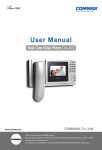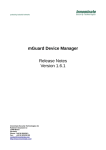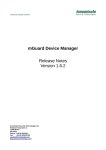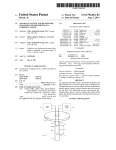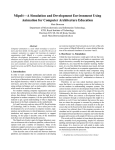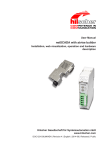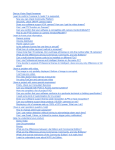Download The Minimeter User`s Manual
Transcript
12 March 2012, 19:05 Preliminary Version TheMinimeterUser’sManual Engineering PhD Björn Breidegard at Certec – Division of Rehabilitation Engineering Research, Department of Design Sciences, Faculty of Engineering, Lund University, Sweden has created the Minimeter. He can be contacted at [email protected] TheMinimeter–enablingcommunicationtechnologyforpeoplewith severebraininjuries The Minimeter is a communication tool developed for people with severe brain injuries. It enables communication, starting at a yes‐no level, for people with exceedingly limited mobility and varying degrees of cognitive difficulties. To lose the ability to communicate is one of the hardest functional impairment a person can have. To obtain the opportunity to express one’s will, wishes and needs by expressing Yes or No is a tremendous step ahead. The Minimeter’s Rolling Ball with its continuous visual and auditive feedbacks gives severely brain injured people this possibility by controlling the rolling Yes‐No‐ball with small head or arm movements. The Yes‐No‐answers given by the user are objective; it is unconditionally the user that generated the answers – without any subjective and often well‐meaning interpretation from related or personnel from health, education and care. Apart from the opportunity to answer yes and no, another important function of The Minimeter is letting the user browse through photos and listen to music in their personal photo and music slide‐ shows. The user together with family, teachers, assistants or friends converse about the photos by using the yes‐no answering mode built in to The Minimeter’s slideshow user interface. By starting in the present and from that point discuss what took place yesterday, the user, with these prerequisites, trains to create the future by planning: “What are we going to do tomorrow?” The ultimate goal of the Minimeter is to provide the users with the possibilities of expressing their will, wishes and needs – to get the opportunity to taking control of their lives. AtypicalMinimetersessioncanbeorganizedlikethis About five serious and sensible questions that are important for the user’s life situation are prepared in advance. Suitable ones are questions concerning today’s activities, choice of clothes, the user’s well‐being, etc. (5 minutes). Slideshow conversation. One new slideshow (including sound/voice) per week is recommended. At Christmas time, for example, one can present the slideshow from last Christmas, and get ideas for the forthcoming Christmas (about 5‐10 minutes). Relaxation and fun with amusing slideshows and the music jukebox. Discuss, joke and entertain each other (5‐10 minutes). At least one Minimeter session per day and several are quite desirable. And of course, this recommended programme should be adapted to the individual user’s interests and skills. Stepbystepinstructions 1. Install the Minimeter software (once and for all), se Basic installation. 2. Connect the gamepad and web camera to USB connectors on the computer. 1 3. Turn on the computer and wait until it has started complete (The hard drive lamp has stopped blinking). 4. Start the Minimeter software (you should have a shortcut on your desktop named “The Minimeter”. 5. Direct the camera at the user’s nose that should be seen in the middle of the camera window. Adjust the distance between the user and the camera so the user’s face almost fills the camera window. 6. The user should be properly seated: in an active “sit up straight‐position” with the nose pointing at the camera. 7. Move the mouse cursor into the camera window, press and hold the left mouse button. Now a yellow square is shown. Move, with the mouse, the square so it covers the user’s nose tip and nostrils. Release the mouse button. A yellow filled circle is now shown on the user’s nose tip. Now The Minimeter’s tracking function is locked to the user’s nose tip as shown, and can track small movements (head turns) approximately in the range of turning from the left edge of the screen to the right edge. The Minimeter will not work for people with large, uncontrolled and unpredictable movements. 8. Choose “Rolling Ball”. 9. Press button 1 on the gamepad to activate the Rolling Ball. 10. Press and keep button 3 pressed. Now the ball is locked to the middle of the screen and is not affected by user movements. 11. Ask a question and then release button 3. 12. Now the rolling ball follows the user’s head turns. The user answers Yes or No by moving the head to the right or to the left respectively. 13. The ideal situation is that the user herself turns her head back to neutral, so the rolling ball returns to the center of the screen. If necessary, the helper, standing behind the user, can assist and turn the head to neutral. 14. When the user has answered and returned to neutral, press button 3 and keep it pressed to avoid irritating and random answers if the user drop the head, starts to cough etc. It is wise to keep button 3 pressed except when the user is supposed to give an answer. Button 3 also centers the rolling ball to the middle of the screen – useful if the user is not able to return to neutral. Always hold a finger ready to press button 3 to quickly “freeze” the rolling ball. 15. When finished, press the large “X” in the upper right of the screen to quit the rolling ball window. 16. The Minimeter window with its video window is now seen again. 17. Now choose “Photo Show”. 18. With the gamepad’s touchpad press “up” to choose slideshow number 1 and so on. Change slideshow by pressing “up” or “down”. 19. Press button 1 to activate user control. 20. The user changes picture by head turns (exactly like answering yes or no) to the right (showing next the picture) or to the left (showing the previous picture) 21. Be prepared to “freeze” the user control by pressing button 3 if the user starts making no voluntary movements. 22. NB: If the helper keeps button 4 pressed during “Photo Show” user head turns will generate yes‐ no‐answers instead of picture change. Make extensive use of this possibility to converse converse about the photos. Train to create the future by planning: “What are we going to do tomorrow?” 2 23. When finished, press the large “X” in the upper right of the screen to quit the photo show window. 24. And finally: close the Minimeter window. Om Minimetern under arbetets gång börjar svara dåligt på användarens huvudrörelser, gå till Minimeterns startfönster och markera nästipp/näsborrar igen med den gula rektangeln. Om ni tycker ”det hela” verka fungera konstigt, kryssa ner Minimetern helt och starta om. Om detta inte hjälper, starta om datorn. Om detta inte heller hjälper, stäng datorn, gå och ta en kopp kaffe, och pröva sen igen. Så illa brukar det dock inte vara, Minimetern är pålitlig – men ovanstående råd är tyvärr tillämpliga i det dagliga umgänget med datorer. Personalsettings Det finns två inställningar som kan behövas ändras beroende av användarens rörelseförmåga och vana. Du hittar dessa högst upp i fönstren för ”Rolling Bowl” och ”Photo Show”: The Rolling Ball and Photo Show interfaces can be individually adapted by the modification of two parameters: weight and gear. The weight can be altered from giving a sensation of a light fluttering balloon to a heavy bowling ball. The correct weight filters out short unintentional head movements. It takes some time for the ball to accelerate from a standing position; the entire time the user is able to see what the ball is doing and can directly modify the movements. The gear can be altered bet‐ ween one outer position, where millimeter‐sized turns of the head result in greater movement of the ball, and the other position where it requires considerably greater turns of the head to move the ball. Gear On initial trials, the gear is often set high: slight (barely visible) turns of the head result in big movements of the ball on the screen. This helps the user to understand that she is the one who is actually moving the ball even if the movement is minimal. And she can start reliably answering yes or no with these tiny, tiny movements. Gradually, one strives to reduce the gear in order to increase, through training, head turns that are a bit larger and more accurate. Lagom är kanske 12 till 35 här. Pröva och experimentera på er själva. Weight (named LPWeight) Värden från 0.90 till 0.95 kan vara lämpliga. Pröva på er själva. A greater weight can also be beneficial to minimize the effect of involuntary movements such as twitches, tremors or spasms. Generalizedguidelinesfordesignersandassistants The demands on structuring are great for both test usage and long‐term usage. The end users are so limited in their own functioning and have such short concentration spans that every possible step should be taken to reduce initial or continuous unnecessary difficulties: Always test on yourself first. Always prepare the introduction by placing yourself in the wheelchair, testing and using the different controls and user interfaces, and experiencing the feedback yourself. Spare the users the imperfections, program bugs, poorly designed user interfaces or hastily designed applications. 3 Create a structured learning situation. The usage opportunities should be regular and preferably daily. The schedule and content should be deliberate – is this meaningful to train in relation to the user’s situation and abilities and what you know about the user? Preferably use the same schedule and structure for each usage opportunity so that everybody will be familiar with the routines. Place demands on the user, have well‐prepared questions, and support the user with direct feedback. Create a meaningful learning situation. Always have about five well‐prepared and meaningful questions for the user. Make sure that the user really understands that she actually decides herself through the answers, and that the people around her respect and comply with her decisions and act according to them. Practice. Regular practice yields results but it can take a long time. Be patient and test different alternatives if problems arise. There are many ways of finding new solutions based on rehabilitation technological considerations. It may be functional to question at the very outset whether the solution should fully imitate the solution for a non‐handicapped person (the parrot method), have the same purpose but a different form (the chameleon method), or be completely different and only retain its fundamental feature – its very core (the poodle method), see www.certec.lth.se/doc/certecscore/index_t.html. Dare. Dare to be open‐minded and test new things. Often you cannot know until you have tried. The user has probably more abilities than she has exposed to you up to now. Be self‐confident. The Minimeter usage reveals what the user can do, and in that way, it yields a performance diagnosis. The medical diagnosis does not have this purpose, and a pedagogical diagnosis of the user without the actual tool, (in this case, the yes‐no answerer), cannot tell what abilities she might possess together with her technology. You need to be self‐confident and dare to rely on the user test team’s ever evolving situated knowledge of the user. Work together. This is teamwork. You must be able to learn from and teach each other – and substitute for one another. A person who is experienced and skilled may act as a coach for the others in the team and inspire, empower and encourage them. There is also a need for a joint coach for the user and the team. 4





